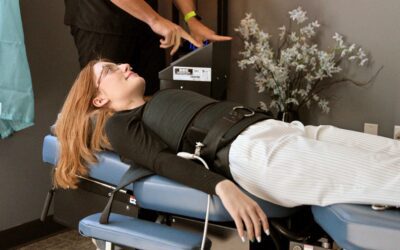Patellofemoral Syndrome (PFS), more commonly known as “runner’s knee”, is a musculoskeletal condition that causes pain around or behind the kneecap (patella). This knee pain often stems from the improper alignment of the patella as it moves over the femur (thigh bone), leading to irritation of the surrounding tissues.
Patellofemoral Syndrome can impact both athletes and non-athletes, significantly affecting daily activities and athletic performance. However, with a proper understanding and a structured chiropractic rehabilitation plan, PFS can be effectively managed and resolved.
Causes and Symptoms
Patellofemoral Syndrome can be caused by various factors, including overuse, muscle imbalances, poor foot mechanics, and trauma. Overuse is common in runners and cyclists, while muscle imbalances might involve weakness or imbalance in the quadriceps, hamstrings, or hip muscles.
Poor foot mechanics, such as flat feet or overpronation, can alter knee alignment, and direct injury to the knee can also result in Patellofemoral Syndrome.
Symptoms typically include knee pain during activities like running, jumping, squatting, or climbing stairs. Discomfort may also occur after prolonged sitting with bent knees.
Additionally, individuals might experience a feeling of instability or the knee “giving way” along with swelling around the kneecap.
Effective Rehabilitation
Rehabilitation for Patellofemoral Syndrome focuses on reducing knee pain, correcting biomechanical issues, and strengthening the muscles around the knee. A successful chiropractic rehab plan generally includes rest and activity modification, pain management, strengthening exercises, stretching and flexibility, improving mobility and alignment, and a gradual return to activity.
Rest and activity modification are crucial in the initial stages. Reducing or eliminating activities that exacerbate the pain allows the knee to recover. Switching to low-impact exercises like swimming or cycling helps maintain fitness without stressing the knee.
Pain management involves using ice therapy, where ice packs are applied to the knee for 15-20 minutes several times a day to reduce inflammation and knee pain. Over-the-counter NSAIDs can also help manage pain and swelling.
Strengthening exercises target the quadriceps and hip muscles to stabilize the knee. Quadriceps exercises, such as straight leg raises and quadriceps sets, are essential. Hip exercises, like clamshells and side-lying leg raises, are also beneficial.
Stretching and flexibility exercises are important for the hamstrings, calves, and the iliotibial band. Regularly stretching these muscle groups can improve knee mechanics and reduce pain.
Improving mobility and alignment involves patellar mobilizations and the use of custom foot orthotics if flat feet or overpronation are contributing factors. Gentle manual movements of the patella can enhance its tracking, while custom orthotics can correct foot mechanics and improve knee alignment.
A gradual return to activity includes progressive loading and monitoring symptoms. Gradually reintroducing weight-bearing activities as pain allows, ensuring proper technique and alignment, is key. Keeping track of pain levels and adjusting activities accordingly helps prevent setbacks.
We’re Here To Help
Preventing Patellofemoral Syndrome involves maintaining strength, flexibility, and proper biomechanics. Regular lower body strength training, incorporating stretching into your routine, and wearing appropriate footwear that supports your foot mechanics are essential steps.
Paying attention to early signs of knee pain and addressing them promptly can prevent the progression of PFS.
By following a comprehensive chiropractic rehabilitation program tailored to individual needs and conditions, most people with Patellofemoral Syndrome can return to their normal activities pain-free and with improved knee function.
If you’re ready to learn more about how chiropractic care can improve your quality of life, we invite you to schedule an appointment and find out for yourself how chiropractic treatments help you maintain a healthy lifestyle and movement habits to give you a foundation that will help keep you out of pain with health that comes naturally.
Call 417 Spine to schedule an appointment and get started on your path to optimal health.


